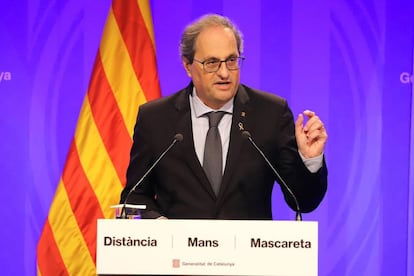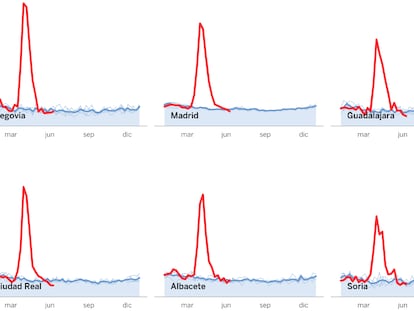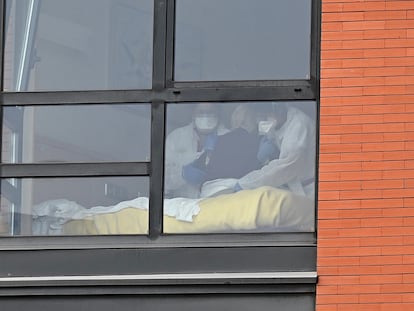Catalonia to enter ‘new normality’ after lifting state of alarm
The Barcelona metropolitan area and Lleida are spending just 24 hours in the last stage of deescalation

Catalan premier Quim Torra on Thursday announced that the region is lifting the state of alarm imposed in mid-March by central authorities in a bid to contain the spread of the coronavirus.
The move, effective at midnight, means that Catalonia as a whole will have spent just 24 hours in Phase 3, the last stage of a national deescalation plan that’s been underway for weeks. Barcelona and its metropolitan area as well as Lleida only entered Phase 3 on Thursday morning, while other parts of the northeastern region did so earlier.
The state of alarm, a constitutional tool granting the central government emergency powers, will formally expire across Spain on Sunday, June 21. But regions in Phase 3 have been granted the power to decide how long this last stage should last before entering “the new normality.” Galicia was the first region of Spain to exit the state of alarm.
I will not hesitate to make whatever decisions are necessary to ensure the safety of citizensCatalan premier Quim Torra
Torra on Thursday signed a decree formalizing the transition that will take effect after midnight, but warned that until June 25, some restrictions will still apply, such as limits on the number of customers allowed inside restaurants and other commercial premises.
Torra, a hardline Catalan separatist, has been very critical of the central executive’s management of the pandemic. Now that Catalonia is exiting the state of alarm, regional authorities are appealing to society’s sense of responsibility and underscoring three major elements to ensure personal safety: keeping a distance of 1.5 meters between people, washing hands regularly and using a face mask.
“We have to be more prudent than ever after the end of the state of alarm in Catalonia,” said Torra, warning that any excesses or reckless behavior could lead to another strict confinement. “I will not hesitate to make whatever decisions are necessary to ensure the safety of citizens.”
“The government of the Generalitat is recovering its powers. The phases and all the confusion are over,” said the regional health chief, Alba Vergés, in a joint appearance with Torra. Vergés had been very critical of the phase system, which she said was difficult to understand.
“The main thing is not the percentage,” she added, alluding to limits on capacity at public venues. “It’s for people to identify that there is a safe distance wherever it is that they are going.”
The Spanish Health Ministry had agreed on Wednesday to allow Barcelona and its metropolitan area, as well as Lleida, to enter Phase 3 of the coronavirus deescalation plan a few days ahead of schedule. The two healthcare areas have been in Phase 2 for less than two weeks, which is the time allocated for each stage, and they were not set to change stages until June 21.
Phase 2 regions
Only the Madrid region and the provinces of Salamanca, Segovia, Ávila and Soria in Castilla y León currently remain in Phase 2. The premier of Madrid, Isabel Díaz Ayuso, confirmed earlier in the week that the regional government would not request the phase change given that the state of alarm will come to an end on Sunday, June 21, and with it the central government’s control on the deescalation process. “We were going to ask for it, but the effects are exactly the same, it doesn’t make sense,” she told the Spanish television station Telecinco on Monday.
Under Phase 3, regional authorities regain control over the deescalation process and are able to adapt and lift the lockdown measures as they see fit. More people are allowed inside stores; nightclubs and bars can open, and movement within provinces of the same region is also allowed.
The healthcare areas of Barcelona and Lleida were the only ones in Catalonia not to enter Phase 3 on June 8. Barcelona was held back due to the high number of coronavirus cases and high population density, which makes social distancing measures more difficult to implement. And in the case of Lleida, the process was slowed after outbreaks were detected in senior residences, health centers and in the meat industry.
“I think Catalonia has done things correctly. There has been an attitude of prudence, which I share,” said Spanish Health Minister Salvador Illa, adding that the outbreaks in Lleida were quickly brought under control.
State of alarm
The state of alarm was introduced in mid-March in a bid to curb the spread of the coronavirus, and is set to end on Sunday, June 21 at 12am. Illa warned on Wednesday, however, that it could be declared again if there was a coronavirus outbreak “that could not be contained without controlling movement in the entire territory.”
“We don’t think it will be necessary if everyone behaves appropriately and if regional monitoring mechanisms work as they have been working now,” he added.
Asked whether selective confinement measures could be used to control an outbreak, Illa replied it was a possibility: “We will see if confinement is necessary, who has the responsibility to decree it and under what conditions.”
Latest coronavirus figures in Spain
According to the latest figures, a total of 244,683 coronavirus cases have been detected since the beginning of the pandemic. On Wednesday, the Health Ministry reported 355 new coronavirus infections, 144 of which were detected in the previous 24 hours. The regions of Castilla y León, Catalonia and Madrid recorded two third of the new diagnoses.
The weekly infection rate was at 3.36 cases per 100,000 inhabitants on Wednesday, down slightly from Monday’s figure of 3.72. Although this rate can change if just four new cases are detected, the drop confirms the downward trend of the outbreak.
A total of 124,732 coronavirus patients have required hospitalization since the beginning of the pandemic, 97 of whom were admitted in the last seven days, according to Wednesday’s report. In this same period, 10 patients were admitted into intensive care units (ICU). This is a rise from Tuesday, when there were six ICU admissions.
Tu suscripción se está usando en otro dispositivo
¿Quieres añadir otro usuario a tu suscripción?
Si continúas leyendo en este dispositivo, no se podrá leer en el otro.
FlechaTu suscripción se está usando en otro dispositivo y solo puedes acceder a EL PAÍS desde un dispositivo a la vez.
Si quieres compartir tu cuenta, cambia tu suscripción a la modalidad Premium, así podrás añadir otro usuario. Cada uno accederá con su propia cuenta de email, lo que os permitirá personalizar vuestra experiencia en EL PAÍS.
¿Tienes una suscripción de empresa? Accede aquí para contratar más cuentas.
En el caso de no saber quién está usando tu cuenta, te recomendamos cambiar tu contraseña aquí.
Si decides continuar compartiendo tu cuenta, este mensaje se mostrará en tu dispositivo y en el de la otra persona que está usando tu cuenta de forma indefinida, afectando a tu experiencia de lectura. Puedes consultar aquí los términos y condiciones de la suscripción digital.
More information
Últimas noticias
There is as much life left to discover on planet Earth as that which is already known
Dozens presumed dead, around 100 injured in fire at Swiss Alps bar during New Year’s celebration
Is porn for women different from conventional porn? We spoke to those who make it
Cartagena de Indias is sinking: What can the city do to mitigate it?
Most viewed
- Reinhard Genzel, Nobel laureate in physics: ‘One-minute videos will never give you the truth’
- David King, chemist: ‘There are scientists studying how to cool the planet; nobody should stop these experiments from happening’
- Sinaloa Cartel war is taking its toll on Los Chapitos
- Oona Chaplin: ‘I told James Cameron that I was living in a treehouse and starting a permaculture project with a friend’
- The Interoceanic Train, the Mexican alternative to the Panama Canal










































